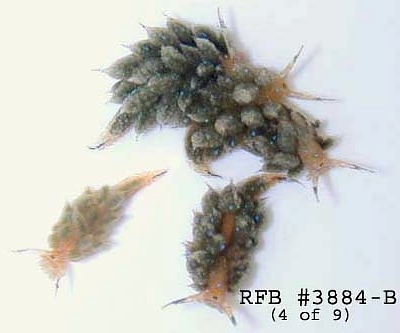
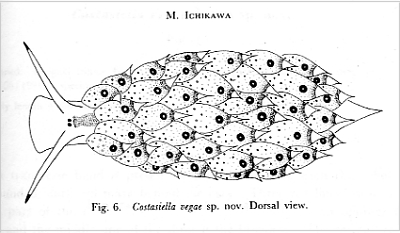
Costasiella vegae
Ichikawa, 1993
Order: SACOGLOSSA
Superfamily: LIMAPONTIOIDEA
Family: Costasiellidae
DISTRIBUTION
Northwest Pacific
PHOTO
Upper: Seragaki, 180 ft (55 m), Okinawa, Japan, Pacific, 8 August, 2001, mixed coral rubble and sand with numerous thallophytes. Length: 2~5mm. Photographer: R. F. Bolland. Lower: Fig. 6, dorsal view of C. vegae from Ichikawa, 1993.
The most distinctive feature of this species appears to be the bright blue, or white spot on the upper side of each ceras. The spot is sometimes surrounded by a dark green ring. Ther can be a similar mark behind the eyes in the dorsal midline, but this can lack the ring, and be reddish in colour. A reddish subapical band can also be present on the cerata. It grows to about 10 mm and is found on the green algae Avrainvillea.
It is very possible that this is synonymous with the Caribbean species C. ocellifera. See comments in attached messages.
-
Ichikawa, M. (1993) Saccoglossa Opisthobranchia) from the Ryukyu Islands. Publications of the Seto Marine Biological Laboratory, 36: 119-139.
Rudman, W.B., 2006 (November 28) Costasiella vegae Ichikawa, 1993. [In] Sea Slug Forum. Australian Museum, Sydney. Available from http://www.seaslugforum.net/find/costvega
Related messages
Costasiella vegae from New Caledonia
September 21, 2007
From: jean-François Hervé
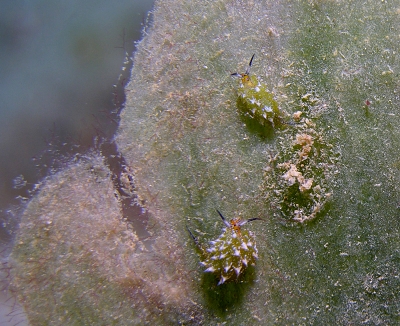
Dear Bill,
Could you help me to ID the two little limapontiids in this and the accompanying message [#20752] which we sometimes see on this algae. Maybe this is Costasiella ocellifera ?
Locality: Noumea, Ouemo Beach, 10 m, New Caledonia, Pacific ocean, July and January 06, Algae. Length: 5 mm. Photographer: Jean-François Hervé.
Best wishes.
Jean-François Hervé
jfherve@free.fr

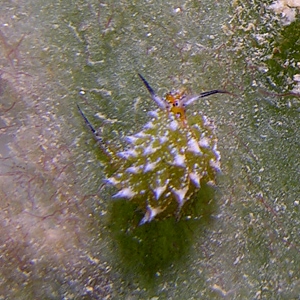
Dear Jean-François,
Costasiella ocellifera is pretty close, but that is considered to be a Caribbean species. I have identified your animal previously as Costasiella vegae, which seems to be the West Pacific 'version' of C. ocellifera.
All species of Costasiella seem to feed on green algae of the genus Avrainvillea which could well be the algae your animals are on. If you have a higher resolution photo showing the slugs in more detail I would like to add it to the Forum so we have a better idea of the colour pattern variation in this species.
Best wishes,
Bill Rudman
Costasiella ocellifera? from Okinawa
November 29, 2006
From: Robert F. Bolland

Concerning message #18452:
Hi Bill,
Here's another Costasiella from Okinawa, similar to Atsushi Ono's animal on a recent Forum post.
Data: RFB #3585-C / TL: 4mm / 55m / Seragaki, Okinawa / 4 May 1997
RFB #3884-B / TL: 2~5mm / 55m / Seragaki, Okinawa / 8 August 2001
I've collect sixteen of these, specimens deposited with Terry Gosliner at CAS.
Locality: Seragaki, 180ft (55m), Okinawa, Japan, Pacific, 4 May, 1997 / 8 August, 2001, mixed coral rubble and sand with numerous thallophytes. Length: 2~5mm. Photographer: R. F. Bolland.
Cheers,
Bob
bollandr@rapid-link.ne.jp


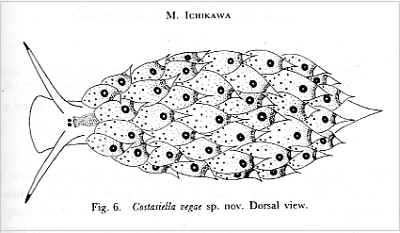
Dear Bob,
Thanks for these photos. They certainly clarify the picture - at least in my mind - and illustrate the confusion that can occur by naming new species on very little information. Your animals seem to fit the description of Costasiella vegae Ichikawa 1993.
The most distinctive feature of C. vegae seems to be the eye spot on each cerata. However Ichikawa described the eyespots as being 'a whte spot encircled by a dark green ring'. In both your animals and Atsushi Ono's the spots are blue, and while the ones in your upper photo are surrounded by a dark green ring, the ring is absent in Atsushi Ono's, and your lower photo. Also Ichikawa describes a distinctive maek behind the eyes as 'a conspicuous red mark behind the eyes like a posteriorly pointing arrow head' which is not clear in the drawiing of the animal. I suspect the mark is the blue eye spot or mark found in your animals and Atsushi Ono's. Ichikawa also describes a red subapical band around the cerata. This is not visible in Atsushi Ono's or your animals but there is an orange subapical band around the cerata of C. ocellifera from the Caribbean. Ichikawa's description of C. vegae was based on 6 specimens collected at the Ryukyu Islands on Avrainvillea. I suspect your animals and Atusushi Ono's are part of the colour variation of C. vegae. I also suspect that C. vegae is the same as the Caribbean C. ocellifera.
Best wishes,
Bill Rudman
Caribbean Costasiella ocellifera from Okinawa?
November 22, 2006
From: Atsushi Ono

Dear Bill:
In Okinawa, I found this individual which looks very much like Costasiella ocellifera. There might not have been problem if this individual had been found in the Caribbean Sea! To my regret,because egg ribbon is not found , the development type is uncertain. This individual was growing on Avrainvillea lacerata var. robustior between branches of Porites (Synaraea) rus of 9m in depth.
Locality: Kerama Is. Okinawa, 9m, Japan, East China Sea, July 2006. Length: 4mm. Photographer: Atsushi Ono.
Atsushi Ono
ononini@cosmos.ne.jp
Atsushi Ono, 2006 (Nov 22) Caribbean Costasiella ocellifera from Okinawa?. [Message in] Sea Slug Forum. Australian Museum, Sydney. Available from http://www.seaslugforum.net/find/18452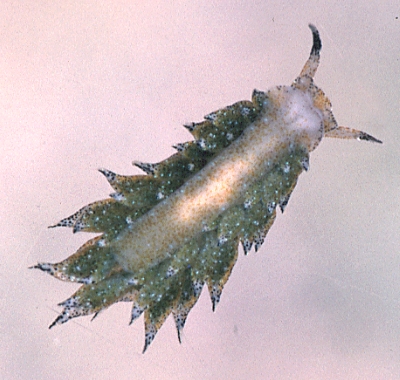
Dear Atsushi,
This is indeed an interesting find. As you suggest, A. ocellifera is known only from the Caribbean so if this is the same species, then its discovery in Okinawa suggests that it may have been transported by shipping. Is it A. ocellifera? The only external difference I can see is that the small black spots found in Caribbean animals seem to have been replaced by orange-brown spots on the body and sole of the foot. This shift from black to orange pigment seems to be quite a common occurrence in opisthobranchs, so my feeling is that this is indeed A. ocellifera.
Comments from experts would be very welcome.
Best wishes,
Bill Rudman
